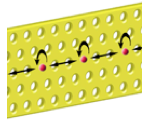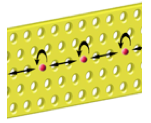Light takes a solid position
From both the theoretical and experimental points of view, it is difficult to work with real materials where the interactions between electrons are strongly correlated. Artificial structures called “quantum simulators” are designed to mimic these complex many-body systems and possess a tunable parameter analogous to, for example, temperature or density in a real solid.
Writing in Physical Review A, James Quach and colleagues at the University of Melbourne in Australia are analyzing one suggested model for quantum simulators that consists of a series of single two-level atom cavities that are evanescently coupled together to form a one-dimensional lattice. The infinite lattice approximation of this model system predicts quantum phase transitions analogous to the superfluid transition in the Bose-Hubbard model, one of the most widely used models to describe solid-state systems. Quach et al. calculate the band structure of light in their system and find that phase transitions arise from the interaction of photons with themselves. The photons in this system therefore behave like electrons and can repel one another, leading to the term “solid light.” Quach et al. take advantage of techniques used by both the optics and the solid-state communities to show how semiconductor properties can be simulated. Their investigation has also uncovered new features with no semiconductor analog. – Frank Narducci





